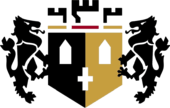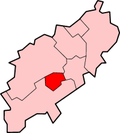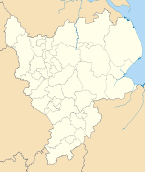Local government in Northampton
| Northampton Borough Council | |
|---|---|
 | |
| Type | |
| Type |
Non-metropolitan district council of Northampton |
| Leadership | |
Leader | |
Deputy Leader | |
Mayor | |
Deputy Mayor | |
| Structure | |
| Seats | 45 |
Political groups |
Conservative Party (25) Labour Party (14) Liberal Democrats (5) UK Independence Party (1) |
| Elections | |
| First-past-the-post | |
Last election | 5 May 2011 |
| Meeting place | |
| The Guildhall, St. Giles Square, Northampton | |
| Website | |
| www.northampton.gov.uk | |
Northampton Borough Council is the borough council and non-metropolitan district responsible for local government in the large town of Northampton in England. The leader and cabinet model of decision-making has been adopted by the council. It consists of 45 councillors, representing 33 wards in the town, overseen by a Mayor, Leader and Cabinet. It is currently controlled by the Conservative Party and has been led by David Mackintosh since his election on 6 May 2011. The main council building is Northampton Guildhall.
As a non-metropolitan district, the council is responsible for local planning and building control, local roads, council housing, environmental health, markets and fairs, refuse collection and recycling, cemeteries and crematoria, leisure services, parks, and tourism.
History
Northampton was granted its first town charter in 1189 by King Richard I and was permitted the appointment of a Mayor in 1215 by King John. Northampton first existed as an ancient borough in medieval Britain before being one of the 178 boroughs to be reformed under the Municipal Corporations Act in 1835. Under the Local Government Act, it was then recognised as a county borough of 6 wards from 1898, 9 wards from 1900 and 12 wards from 1911.[1] Northampton was granted modern borough status in 1974 under the Local Government Act 1972 as Northampton Borough Council, a non-metropolitan district council under Northamptonshire County Council.[2][3]
Northampton is now the most populous urban district in England not to be administered as a unitary authority, a status it failed to obtain in the 1990s local government reform.[4] During the Local Government Commission for England (1992), Northampton was rejected from becoming a unitary authority because it was decided that "the separation of Northampton from its county would have a significant and detrimental effect."[5][6][7] The government announced its acceptance of these recommendations in March 1996.[8] In 2000, Northampton applied unsuccessfully for city status, held to celebrate the new millennium.
Governance
The leader and cabinet model of decision-making, adopted by the borough council under the Local Government Act 2000, is similar to national government. The council appoints the Leader (usually a member of the group with the political majority) and he or she appoints up to five other councillors to serve on the cabinet. The cabinet members assume responsibility for different key areas of local governance including environment; community engagement; housing; planning, regeneration and enterprise; and finance.
The full council meets various times a year. The full council set the annual budget and the council's overall policies. It also has responsibility for amendments to the council's constitution and is responsible for appointing the Leader, the Executive, and the Committees of the council.
Cabinet members
| Title | Cabinet member | Assistant Cabinet member |
|---|---|---|
| Leader of the Council | David Mackintosh | N/A |
| Deputy Leader of the Council | Mary Markham | N/A |
| Community Engagement | Brandon Eldred | Anna King |
| Environment | Mike Hallam | Brian Oldham |
| Finance | Alan Bottwood | N/A |
| Housing | Mary Markham | Matt Lynch |
| Planning, Regeneration and Enterprise | Tim Hadland | Jonathan Nunn |
Political control
Political control of the non-metropolitan district has been held by the following groups:
| Election | Party | |
|---|---|---|
| 1973 | Labour | |
| 1976 | Conservative | |
| 1979 | Conservative | |
| 1983 | No overall control Con largest single party | |
| 1987 | Conservative | |
| 1991 | No overall control | |
| 1995 | Labour | |
| 1999 | Labour | |
| 2003 | No overall control Con largest single party | |
| 2007 | Liberal Democrats | |
| 2011 | Conservative | |
The council comprises 45 councillors who represent the borough. Each councillor typically serves for a four-year term, representing an electoral ward. Each ward elects between one to three councillors by the first past the post system of election.[9] The current composition of the borough council, following the 2011 election and a subsequent defection,[10] is 25 Conservative councillors, 14 Labour councillors, 5 Liberal Democrat councillors, and 1 UKIP councillor. The next election will take place in May 2015.
| Ward | Councillor(s) | Political control | |
|---|---|---|---|
| Abington | Tony Ansell Ifty Choudary | Conservative | |
| Billing | David Palethorpe (Lab) Christopher Malpas (Con) | No overall control | |
| Boothville | Jamie Lane | Conservative | |
| Brookside | Lee Penelope Mason | Labour | |
| Castle | Mohammed Aziz Winston Strachan Danielle Stone | Labour | |
| Delapre and Briar Hill | Geraldine Davies (Lab) Brendan Glynane (LD) Mick Ford (LD) | No overall control | |
| East Hunsbury | Brandon Eldred Phil Larratt | Conservative | |
| Eastfield | Elizabeth Gowen | Labour | |
| Headlands | Ven Sivaramen | Labour | |
| Kings Heath | Roger Conroy | Liberal Democrat | |
| Kingsley | Beverley-Anne Mennell | UKIP | |
| Kingsthorpe | Sally Beardsworth | Liberal Democrat | |
| Nene Valley | Michael Hill Jonathan Nunn | Conservative | |
| New Duston | Matthew Golby John Caswell | Conservative | |
| Obelisk | Mary Markham | Conservative | |
| Old Duston | Timothy Hadland Suresh Patel | Conservative | |
| Park | Norman Duncan | Conservative | |
| Parklands | Mike Hallam | Conservative | |
| Phippsville | Anna King | Conservative | |
| Rectory Farm | David Mackintosh | Conservative | |
| Riverside | Stephen Hibbert | Conservative | |
| Rushmills | Penny Flavell | Conservative | |
| Semilong | Les Marriott | Labour | |
| Spencer | Gareth Eales | Labour | |
| Spring Park | John Yates | Conservative | |
| St David's | Naz Choudary | Labour | |
| St James | Terry Wire | Labour | |
| Sunnyside | Nilesh Parekh | Conservative | |
| Talavera | Joy Capstick (Lab) Dennis Meredith (LD) | No overall control | |
| Trinity | Nahar Begum | Labour | |
| Upton | Alan Bottwood Brian Sargeant | Conservative | |
| West Hunsbury | Brian Oldham | Conservaitve | |
| Westone | Matt Lynch | Conservative | |
See also
References
- ↑ "British History".
- ↑ "District Councils and Boroughs". Hansard 1803–2005. Parliament of the United Kingdom. 28 March 1974. Retrieved 16 January 2012.
- ↑ "Table III(a)". Local Government in England and wales. a Guide to the New System. London: HMSO. 1974. pp. 15–109. ISBN 0117508470.
- ↑ "City winners named". BBC News. 18 December 2000. Retrieved 2 April 2008.
- ↑ Meikle, James (27 September 1995). "Councils fight on for unitary status: Three authorities miss out on all-purpose target". The Guardian.
- ↑ Schoon, Nicholas (20 December 1995). "Nine cities 'need greater powers'". The Independent.
- ↑ LGCE. Final Recommendations on the Future Local Government of: Basildon & Thurrock, Blackburn & Blackpool, Broxtowe, Gedling & Rushcliffe, Dartford & Gravesham, Gillingham & Rochester Upon Medway, Exeter, Gloucester, Halton & Warrington, Huntingdonshire & Peterborough, Northampton, Norwich, Spelthorne and the Wrekin. December 1995.
- ↑ http://www.publications.parliament.uk/pa/ld199596/ldhansrd/vo960314/text/60314w01.htm
|chapter-url=missing title (help). Parliamentary Debates (Hansard). House of Lords. 14 March 1996. col. WA71–WA74. - ↑ "Legislation.gov.uk".
- ↑ http://www.northampton-news-hp.co.uk/Northampton-councillor-defects-Conservative-Lib/story-25458888-detail/story.html?utm_content=buffer33846&utm_medium=social&utm_source=facebook.com&utm_campaign=buffer. Missing or empty
|title=(help)
| |||||||||||||||||||||||||||||||||||||||||||||||||||||||||
| ||||||||||||||||||||||||||||

